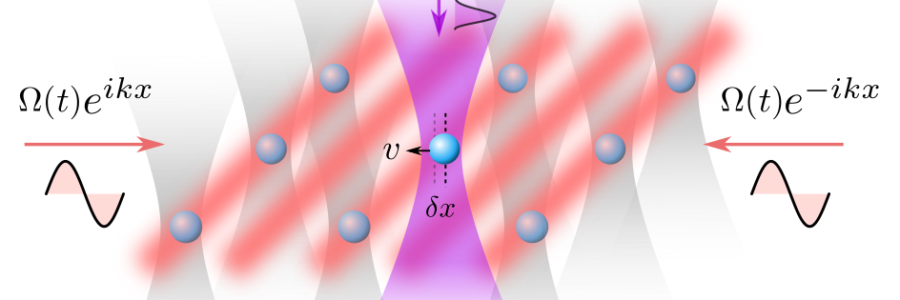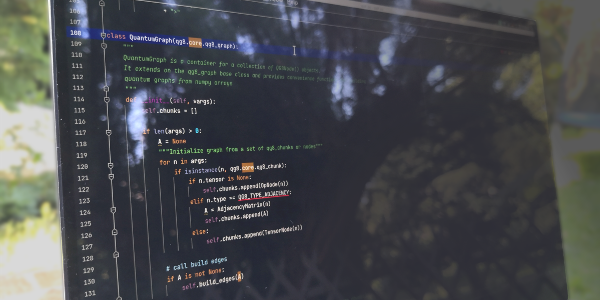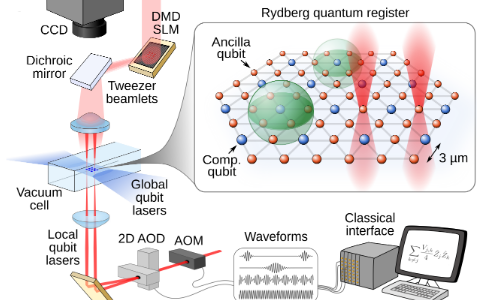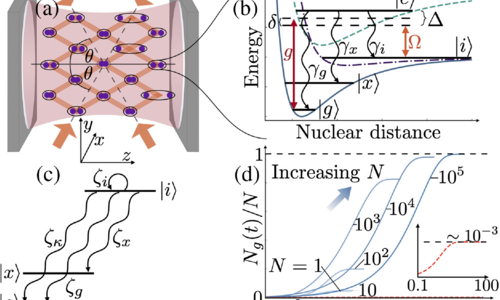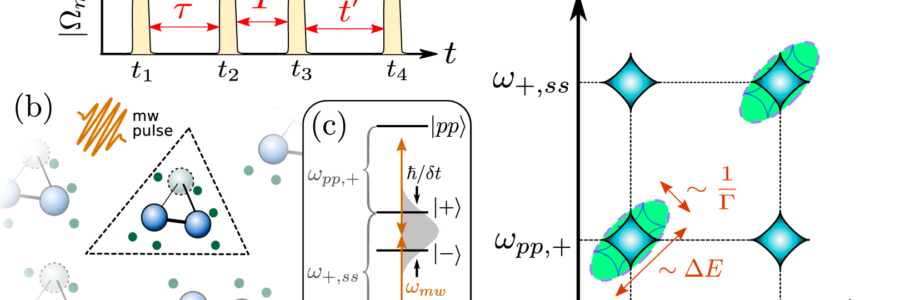We put forward a simple scheme for realizing robust optically controlled quantum gates for scalable atomic quantum processors by driving the qubits with optical standing waves. Compared to existing strategies based on travelling wave lasers, atoms localized close to the antinodes of an optical standing wave can be made to realize phase-controlled quantum operations, even without the need for tight focusing of the control lasers, that are inherently much less sensitive to atomic position variations and atomic motion, thus providing a route to circumvent several dominant errors for atom based quantum processors. S. WhitlockRobust phase-controlled gates for scalable atomic quantum processors using optical standing waves.arXiv:2210.00576, Quantum, in press (2023)
Category: Publications
For a full list of publications by the Exotic Quantum Matter group, please see Google scholar citations
QG8 file specification and programmers reference
QG8 is a lightweight format for storing and exchanging numerical tensor data and data flow graphs in a binary format. It was created as way to store quantum models and data in a single file including quantum gate and quantum circuit specifications, control pulse definitions, time independent and time-dependent model Hamiltonians, device characteristics, calibration data and noise models, user defined control flow instructions and simulation or measurement results. This facilitates numerical simulation and optimization of quantum problems as well as interfacing with quantum computers. Github repository, including python and C/C++ libraries
Quantum simulation and computing with Rydberg-interacting qubits published in AVS Quantum Science (invited review)
Arrays of optically trapped atoms excited to Rydberg states have recently emerged as a competitive physical platform for quantum simulation and computing, where high-fidelity state preparation and readout, quantum logic gates and controlled quantum dynamics of more than 100 qubits have all been demonstrated. These systems are now approaching the point where reliable quantum computations with hundreds of qubits and realistically thousands of multiqubit gates with low error rates should be within reach for the first time. In this article we give an overview of the Rydberg quantum toolbox, emphasizing the high degree of flexibility for encoding qubits, performing quantum operations and engineering quantum many-body Hamiltonians. We then review the state-of-the-art concerning high-fidelity quantum operations and logic gates as well as quantum simulations in many-body regimes. Finally, we discuss computing schemes that are particularly suited to the Rydberg platform and some of the remaining challenges on the road to general purpose quantum simulators and quantum computers. M. Morgado & S. Whitlock, Quantum simulation and computing with Rydberg-interacting qubitsAVS Quantum Science (invited review), 3, 023501 (2021)Open access: arXiv:2011.03031
Hydrodynamic Stabilization of Self-Organized Criticality in a Driven Rydberg Gas published in Phys. Rev. Lett.
Signatures of self-organized criticality (SOC) have recently been observed in an ultracold atomic gas under continuous laser excitation to strongly interacting Rydberg states [S. Helmrich et al., Nature, 577, 481–486 (2020)]. This creates unique possibilities to study this intriguing dynamical phenomenon under controlled experimental conditions. Here we theoretically and experimentally examine the self-organizing dynamics of a driven ultracold gas and identify an unanticipated feedback mechanism originating from the interaction of the system with a thermal reservoir. Transport of particles from the flanks of the cloud toward the center compensates avalanche-induced atom loss. This mechanism sustains an extended critical region in the trap center for timescales much longer than the initial self-organization dynamics. The characteristic flattop density profile provides an additional experimental signature for SOC while simultaneously enabling studies of SOC under almost homogeneous conditions. We present a hydrodynamic description for the reorganization of the atom density, which very accurately describes the experimentally observed features on intermediate and long timescales, and which is applicable to both collisional hydrodynamic and chaotic ballistic regimes. K. Klocke, T. M. Wintermantel, G. Lochead, S. Whitlock, and M. BuchholdHydrodynamic Stabilization of Self-Organized Criticality in a Driven Rydberg GasPhys. Rev. Lett. 126, 123401 (2021)
Glassy Dynamics in a Disordered Heisenberg Quantum Spin System published in Phys. Rev. X
Understanding the dynamics of strongly interacting disordered quantum systems is one of the most challenging problems in modern science, due to features such as the breakdown of thermalization and the emergence of glassy phases of matter. We report on the observation of anomalous relaxation dynamics in an isolated XXZ quantum spin system realized by an ultracold gas of atoms initially prepared in a superposition of two different Rydberg states. The total magnetization is found to exhibit subexponential relaxation analogous to classical glassy dynamics, but in the quantum case this relaxation originates from the buildup of nonclassical correlations. In both experiment and semiclassical simulations, we find the evolution toward a randomized state is independent of the strength of disorder up to a critical value. This hints toward a unifying description of relaxation dynamics in disordered isolated quantum systems, analogous to the generalization of statistical mechanics to out-of-equilibrium scenarios in classical spin glasses. A. Signoles, T. Franz, R. Ferracini Alves, M. Gärttner, S. Whitlock, G. Zürn, and M. WeidemüllerGlassy Dynamics in a Disordered Heisenberg Quantum Spin SystemPhys. Rev. X 11, 011011 (2021)
Epidemic growth and Griffiths effects on an emergent network of excited atoms published in Nat. Commun.
We have discovered a striking correspondence between the excitation dynamics of a laser driven gas of Rydberg atoms and the spreading of diseases, which in turn opens up a controllable platform for studying non-equilibrium dynamics on complex networks. We show that the competition between facilitated excitation and spontaneous decay of Rydberg excitations results in sub-exponential growth of the excitation number, which is empirically observed in real epidemics. The observed dynamics follow a power-law time dependence that parallels that which is empirically observed in real-world epidemics, providing a powerful demonstration of universality reaching beyond physics; (ii) a full description and interpretation of the experiment in terms of an emergent susceptible-infected-susceptible network linking the observed macroscopic dynamics to the microscopic physics; and (iii) the unexpected presence of rare region effects and a dynamical Griffiths phase associated to the emergent network structure, which gives rise to critical dynamics over an extended parameter regime and explains the appearance of power-law growth and relaxation, but with non-universal exponents. T. M. Wintermantel, M. Buchhold, S. Shevate et al. Epidemic growth and Griffiths effects on an emergent network of excited atoms. Nat. Commun. 12, 103 (2021).
Collective Dissipative Molecule Formation in a Cavity published in Phys. Rev. Lett.
We propose a mechanism to realize high-yield molecular formation from ultracold atoms. Atom pairs are continuously excited by a laser, and a collective decay into the molecular ground state is induced by a coupling to a lossy cavity mode. Using a combination of analytical and numerical techniques, we demonstrate that the molecular yield can be improved by simply increasing the number of atoms, and can overcome efficiencies of state-of-the-art association schemes. We discuss realistic experimental setups for diatomic polar and nonpolar molecules, opening up collective light matter interactions as a tool for quantum state engineering, enhanced molecule formation, collective dynamics, and cavity mediated chemistry. D. Wellnitz, S. Schütz, S. Whitlock, J. Schachenmayer, and G. PupilloCollective Dissipative Molecule Formation in a CavityPhys. Rev. Lett. 125, 193201 (2020)
Two-dimensional spectroscopy of Rydberg gases published in New J. Phys
Two-dimensional (2D) spectroscopy uses multiple electromagnetic pulses to infer the properties of a complex system. A paradigmatic class of target systems are molecular aggregates, for which one can obtain information on the eigenstates, various types of static and dynamic disorder and on relaxation processes. However, two-dimensional spectra can be difficult to interpret without precise knowledge of how the signal components relate to microscopic Hamiltonian parameters and system-bath interactions. Here we show that two-dimensional spectroscopy can be mapped in the microwave domain to highly controllable Rydberg quantum simulators. By porting 2D spectroscopy to Rydberg atoms, we firstly open the possibility of its experimental quantum simulation, in a case where parameters and interactions are very well known. Secondly, the technique may provide additional handles for experimental access to coherences between system states and the ability to discriminate different types of decoherence mechanisms in Rydberg gases. We investigate the requirements for a specific implementation utilizing multiple phase coherent microwave pulses and a phase cycling technique to isolate signal components. K. Mukherjee, H. P. Goswami, S. Whitlock, S. Wüster and A. EisfeldTwo-dimensional spectroscopy of Rydberg gasesNew J. Phys. 22 073040 (2020)
Hundreds of microscopic atomic ensembles in optical tweezer arrays published in npj Q. Info.
Neutral atoms in optical tweezer arrays have recently emerged as one of the most versatile platforms for quantum many-body physics, quantum simulation and computation, where high quality qubits, fast quantum logic gates, quantum entanglement have been demonstrated. So far most of the experimental efforts focus on creating fully occupied arrays with a single atom per tweezer by exploiting light-assisted inelastic collisions and rearrangement to fill empty sites. However, achievable array sizes are limited to ~100 occupied sites due to high power requirements per tweezer, finite trap lifetime, and the increasing complexity associated with the rearrangement process for larger arrays. Here we report a method to overcome this scalability challenge which involves transferring ultracold atoms from a 2D pancake shaped reservoir trap into a large array of optical tweezers produced by a digital micromirror device (DMD) in a single step. We successfully demonstrate, for the first time, fully filled atomic arrays of over 400 tweezers, where each tweezer contains an atomic ensemble (as opposed to single atoms) with microscopic dimensions, controllable atom number and surprisingly small atom fluctuation. We show such a system is well suited for studying quantum spin models, dynamics in novel geometries and realizing collective qubits with enhanced atom-light interactions, or as an starting point for more deterministic single atom preparation schemes. Y. Wang et al., npj Quantum Information 6, 54 (2020)
Unitary and non-unitary quantum cellular automata with Rydberg arrays published in PRL
We propose a physical platform for quantum information processing that is inherently parallelisable, does not require individual addressing and takes full advantage of both unitary and non-unitary multiqubit interactions. The key innovation is the use of programmable multifrequency excitation and depumping of Rydberg states that provides a natural implementation of the so-called quantum cellular automata (QCA) paradigm. We show that this leads to a rich diversity of controllable quantum dynamics in both discrete and continuous time evolution. We also numerically demonstrate that QCA is well-suited for variational optimisation, a hybrid quantum-classical feedback loop that is capable of steering the open quantum dynamics towards highly entangled GHZ states. The generation of such highly entangled states can serve as an valuable resource for quantum sensing and quantum information processing. Our proposed QCA implementation provides a novel and physically viable approach to quantum information processing that is uniquely adapted to the strengths of the Rydberg atom platform. T. Wintermantel et. al., Phys. Rev. Lett. 124, 070503 (2020)

